INSIDE SECRETS OF THE 1999 HONDA CR250
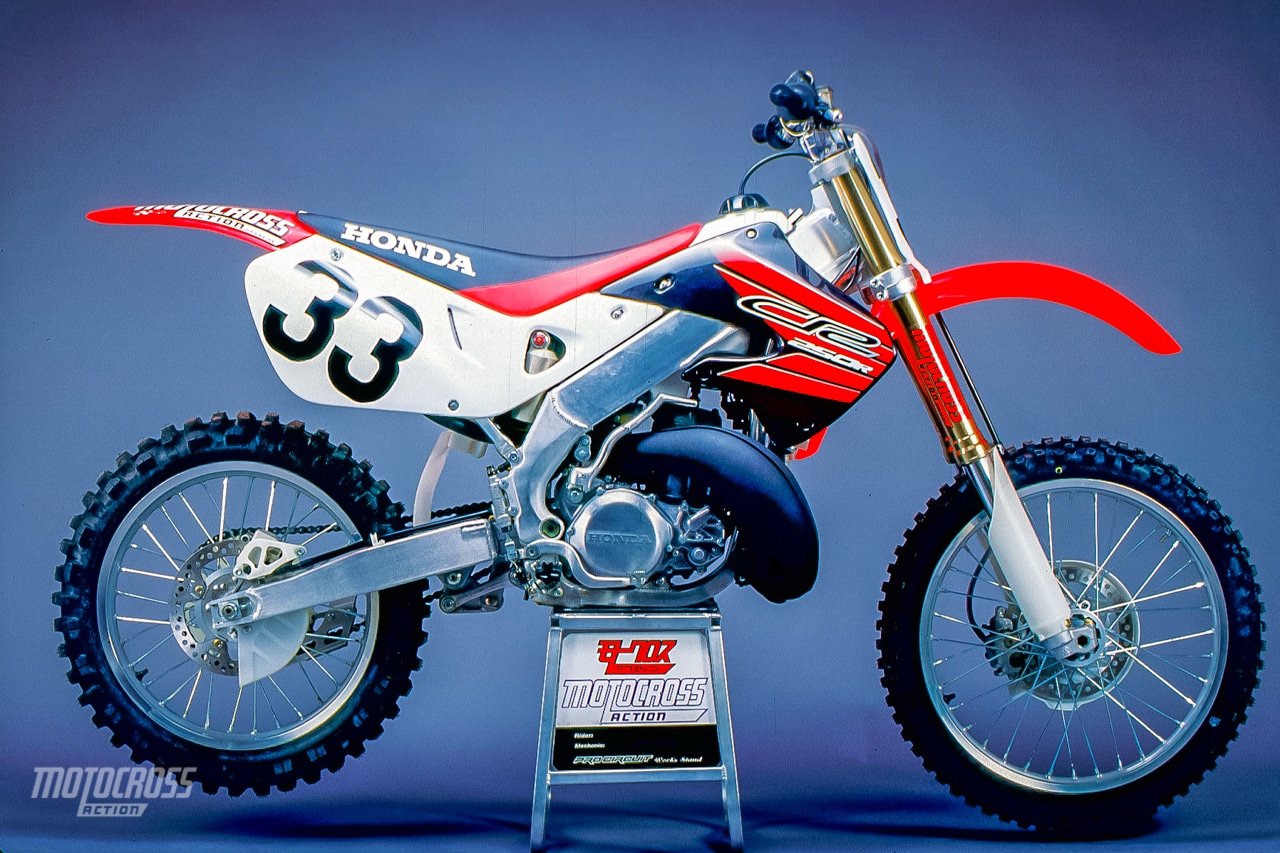 This test of the 1999 Honda CR250 was featured in the August 1999 issue of MXA.
This test of the 1999 Honda CR250 was featured in the August 1999 issue of MXA.
This is everything you need to know about the 1999 Honda CR250. Below are 43 tips, fixes and ailments that you don’t want to live without when riding the first generation aluminum frame CR250.
1. Has your clutch lever come loose yet? Switch the stock pivot bolt nut to a locking nut replacement and blue Loctite it in place. The rear fender bolts also come loose. Do not use thread lock on the rear bolts because this can spin the nut embedded flush inside the plastic fender.
2. Check the spokes often. They get loose more than in the past because the suspension is better and the bike is being pushed harder through the bumps.
3. The chain adjuster and ignition cover bolts should also be checked before each ride.
4. When the tires are off, remove the rim strip and lubricate the spoke nipples with a wet anti-seize compound. Since the spokes require frequent tightening, it makes the nipples easier to turn. Clean the excess lube and run a strip of duct tape around the wheels a few times.
5. The bracket that holds the seat at the front of the tank comes loose. Check the bolts often. Do not Loctite the bolts since it will cause the nut that’s embedded in the tank plastic to spin loose.
6. Since the radiator shroud bolts are in a high maintenance area, grease those bolts to help keep the tank nuts locked in place.
7. Secure the sprocket bolts with red Loctite.
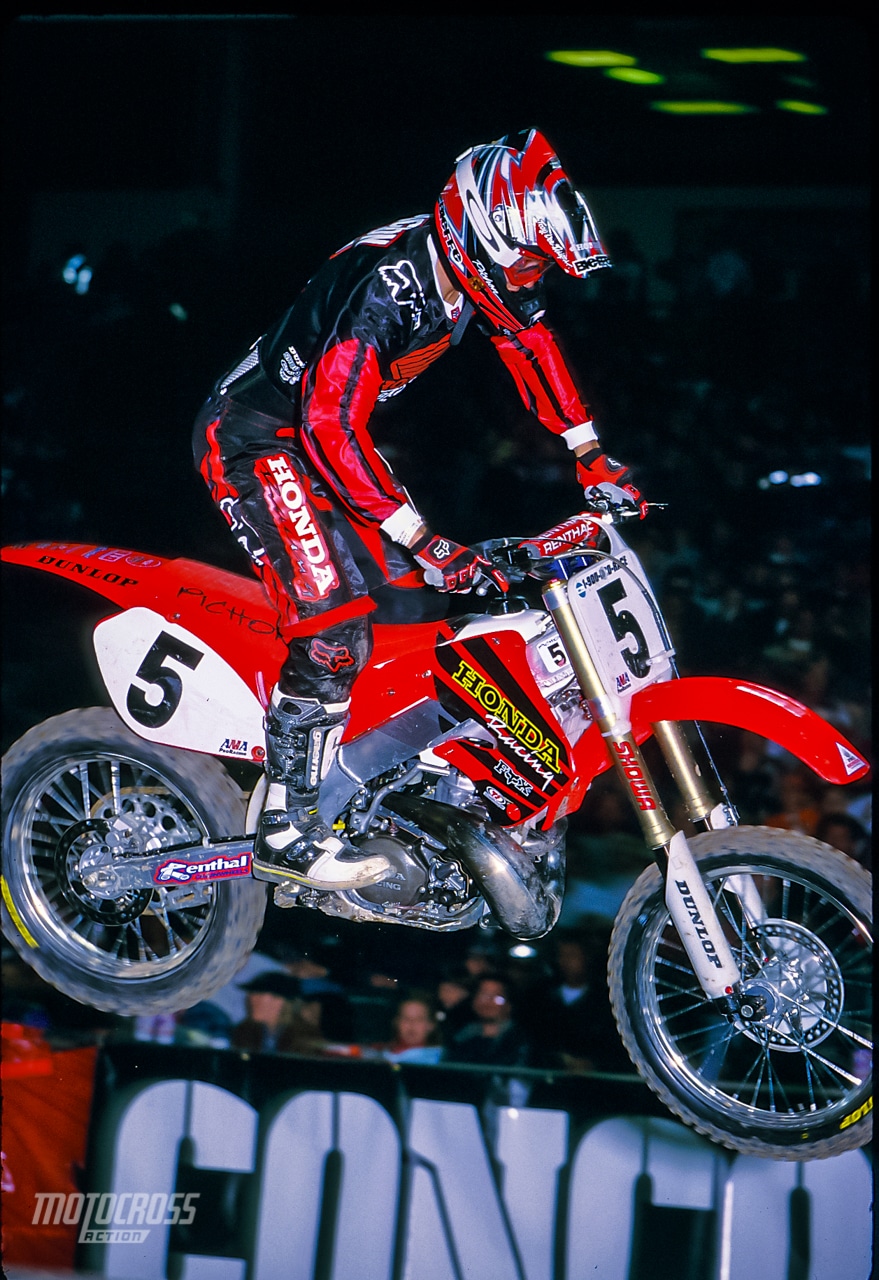 Mickael Pichon on a factory 1999 Honda CR250. Many of these tips were applied to the factory Honda’s back then.
Mickael Pichon on a factory 1999 Honda CR250. Many of these tips were applied to the factory Honda’s back then.
8. If you want to be factory, you will safety wire the throttle cable boots, front sprocket bolt, footpeg pins, steering stem nut, grips and brake house joints.
9. If you don’t put the front wheel in the fork properly it will bind fork movement. Do not tighten the axle by turning the right side nut. Keep the axle nut fully seated and secured by the right fork leg axle pinch bolts. Turn the axle from the left to tighten. Leave the left side axle pinch bolts loose and lightly insert a small screwdriver between the axle split to relieve its clamp on the axle. Pump the forks a few times and, while keeping a load on the fork, remove the screwdriver and tighten the pinch bolts. Re-lube the pivots on a 1-1/2- to 6-month service schedule.
10. The suspension hot-rod shops advise servicing the fork and shock after the first five hours of riding.
11. To find a degree of fork plushness, first remove the springs and measure their overall length. Some springs have been coming up on the short end of the scale, so use spacers to bring the overall measurement to 495mm. Only use steel preload spacers available from a suspension shop.
12. Fill each leg with 378cc’s of Showa SS7. Avoid Honda’s HP oil, which measures as a 7-weight. (Showa SS7 is a lighter 5-weight oil.) Too Tech Suspension runs an ultra-light 3-weight shock oil.
13. An easy way to change oil height without using oil is to make fork oil displacers. Cut six, 25mm-long sections of one-inch diameter, schedule-40 PVC pipe. Cut a lengthwise split in every section. On each fork leg position three PVC pieces on the cartridge rod over the spring seat. When you displace the fork fluid, the oil level is raised and the air space reduced. Each spacer reduces the air space by 5cc, which makes the action more progressive at the end of the stroke. This allows the damping adjusters to be run more open for smoother action and the bike to hold its head up better.
14. For the best overall feel, lower the front by raising the legs 2mm to 3mm up in the clamps. Adjust the forks 12-clicks out on compression and 13 out on rebound. After riding, remove the PVC fluid displacers as necessary to achieve smooth bottoming performance. Most racers run two spacers per leg, while heavier, sumo riders run three.
15. Honda uses chain torque to help the suspension resist bottoming. The way it works is that when the rear suspension collapses, the chain touches the top chain roller. Under power, the top length of chain is taut and it pushes against the top roller, thus helping to fight bottoming. Unfortunately, we think that Honda runs the wrong chain geometry on the CR250. MXA fixes it by running a smaller CR80 chain roller at the top. Now take the original top roller and switch it with the larger-diameter bottom roller. With the chain geometry back in line, it’s crucial to run exactly 25mm to 35mm of chain slack, measured just behind the back of the swingarm’s top chain slider.
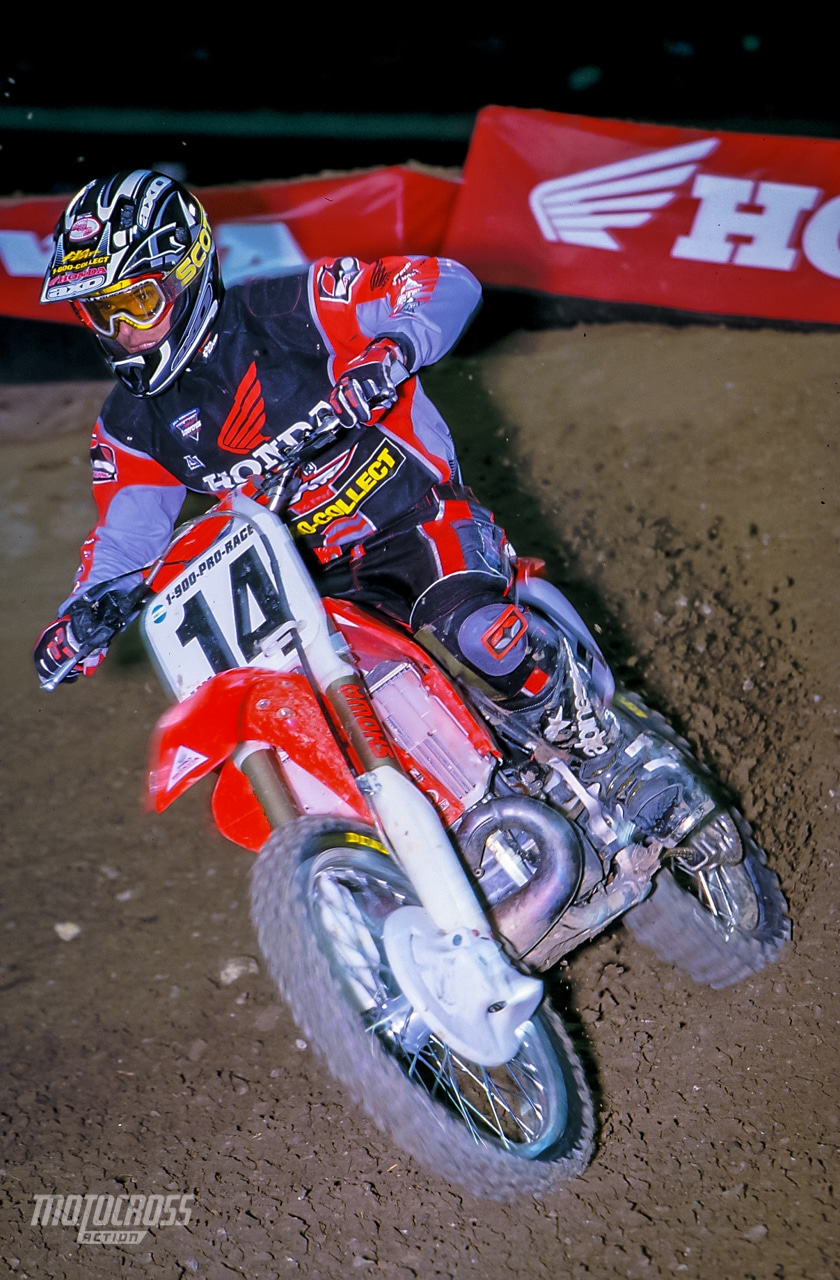 Back in 1999 Kevin Windham rode for factory Honda aboard a CR250.
Back in 1999 Kevin Windham rode for factory Honda aboard a CR250.
16. Changing the gearing can throw the chain geometry completely out of whack. Honda technicians claim that you can improve the chain line and suspension action by using the CR500’s 14-tooth countershaft sprocket and CR125‘s 51-tooth rear sprocket (13/50 stock).
17. With progressive fork action and smoother shock action, it is possible to run more shock preload. Adjust a 98mm ride height, five to six-out on compression, three-turns out on high-speed compression and 12 to 13-out on rebound. Cumulatively, these mods make the rear suspension less sensitive to power forces and softer through hard, square-edged acceleration bumps. The balance will also be much more consistent in turns.
18. Watch the swingarm and chain guide pads. If the chain guide pad wears too far, the chain saws through the guide. Worn swingarm pads will alter chain adjustment and the chain torque’s suspension effect.
19. Your bike comes stock with a chintzy chain. Honda recommends the $100 DID gold chain. It lasts four times longer and seldom requires adjustment.
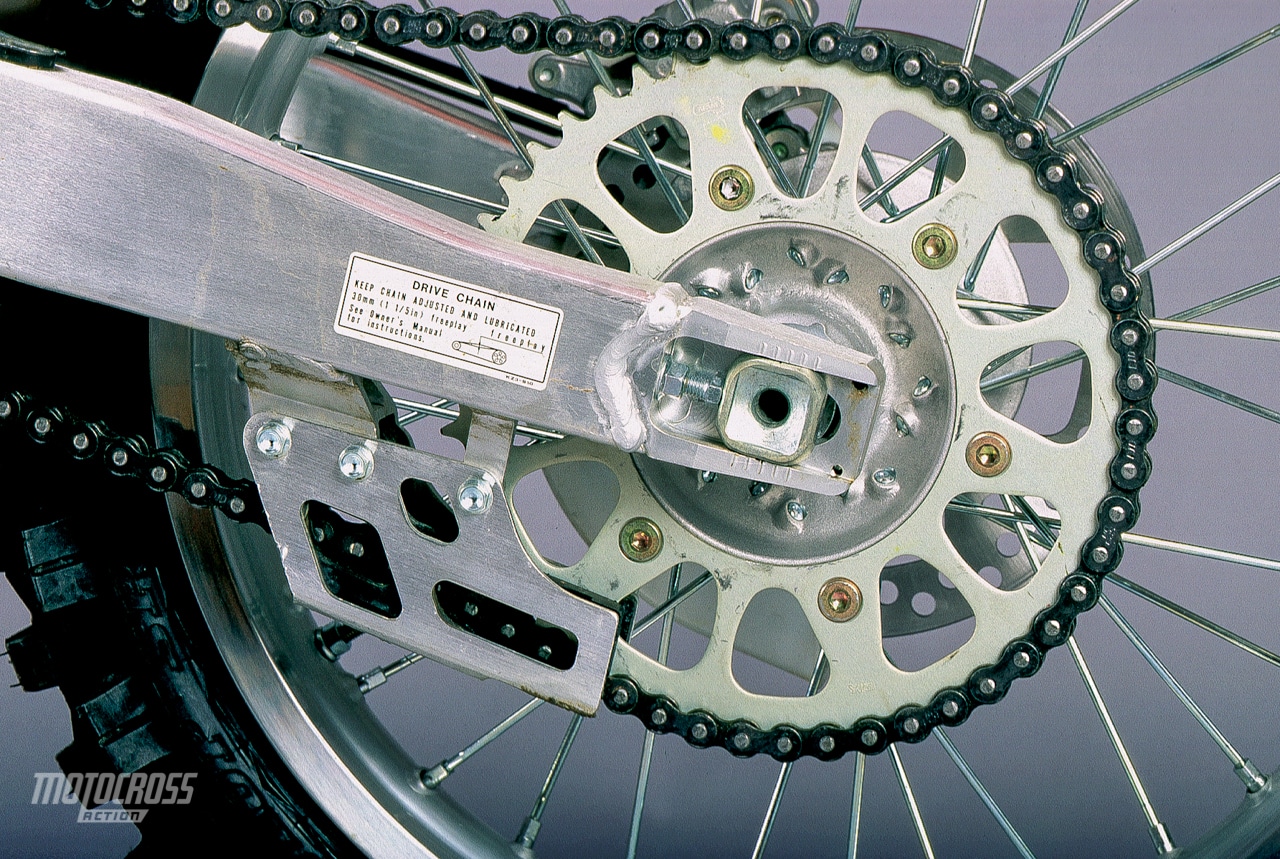 We liked the stock gearing on the 1999 CR250.
We liked the stock gearing on the 1999 CR250.
20. Apply anti-seize to the chain adjuster bolts. When the bolts lose their factory coating, the threads seize and will effectively ruin the swingarm. Throw out the stock nuts and use self-locking replacements. Team FMF says to keep an eye on the swingarm bolts. They bend.
21. For jetting MXA recommends a 172 main, 55 pilot, 1370L needle in the 4th clip and air screw two-turns out. If you need richer response through the midrange, switch to the 1369 needle in the fifth clip. Pro Circuit runs a leaner 168 main, 55 pilot, 1370 needle in the leaner 3rd clip, air screw at 1-1/2 turns out and race gas.
22. Team FMF suggests that the air boot to airbox mount be removed and thoroughly sealed with silicone.
23. Tape the carb vent hoses together and route out near the shock linkage.
24. The kill switch wire pulls taut when turning the bars to the left and can get smashed between the stops turning to the right. Planet Honda protects its kill switch wire with a spiral wrap and reroutes it through the frame behind the steerer tube.
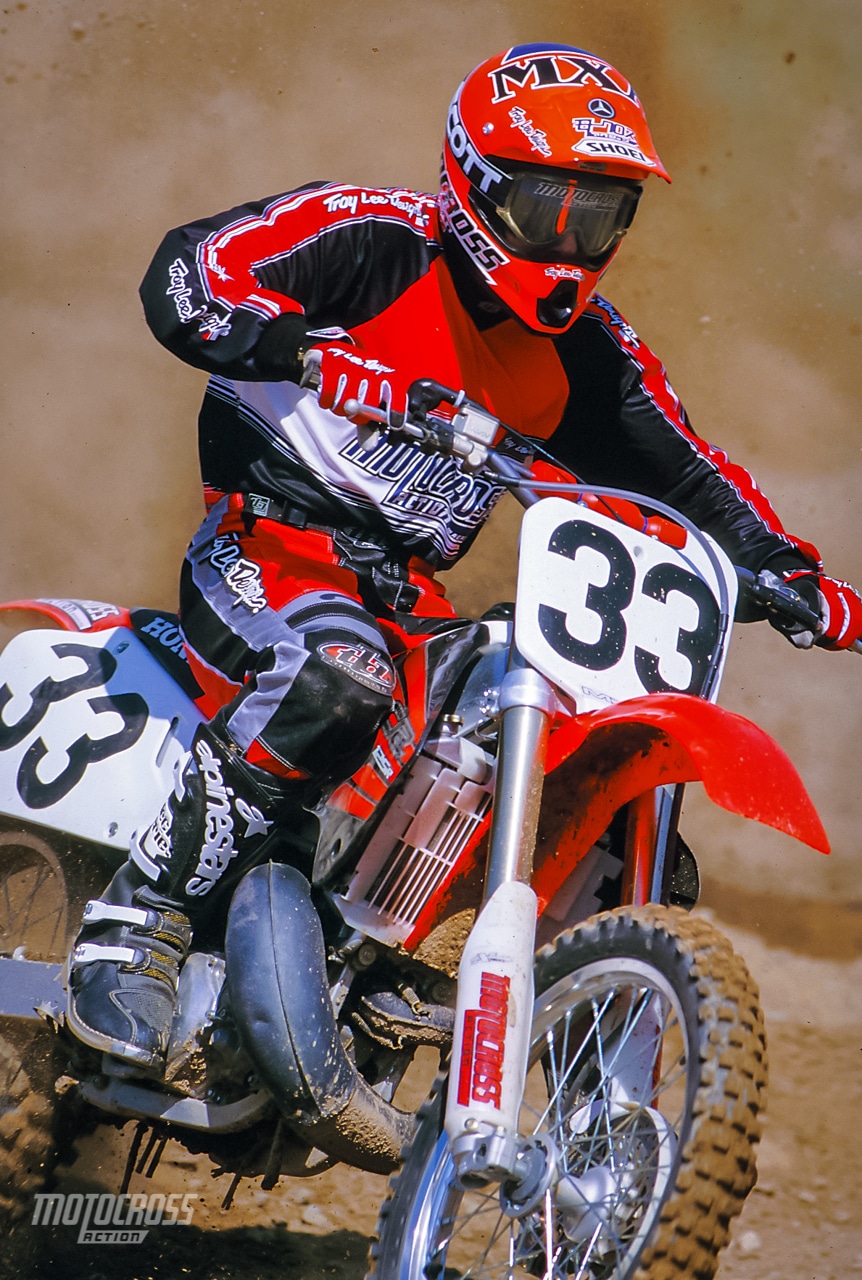
25. The actuating cam on the clutch release lever can be chamfered for easier clutch feel. Planet Honda also polishes the clutch rod for smoother pull. Where the clutch cable makes its sharp 90 degree turn, use a zip-tie and secure it to the front number plate. This reduces cable flex and improves clutch feel. Finally, use a light machine oil to lubricate the cable.
26. Check the throttle cable when running a bar that is taller or wider. Turn the bars from lock to lock and see if the cable is pulled taught or if it bunches up. Carefully reroute as required.
27. An aluminum throttle tube rotates easier on the bar and provides smoother throttle action.
28. Even though the ’99 CR250 handlebar is rubber-mounted, the vault-like aluminum chassis transfers excessive vibration to the grips. Use an aluminum bar and run a bar snake damper. Frequently check the perch torque.
29. Here is a super secret frame trick. Remove the triple clamp and fill each frame spar by shooting spray insulation foam through the relief hole inside the steerer tube. When the foam dries, cut off the excess and reinstall the clamps. This will reduce vibration.
30. Run clear adhesive on the plated footpeg area of the frame, airbox and side plates. This keeps boot-wear induced aluminum oxide from ruining the look of the bike.
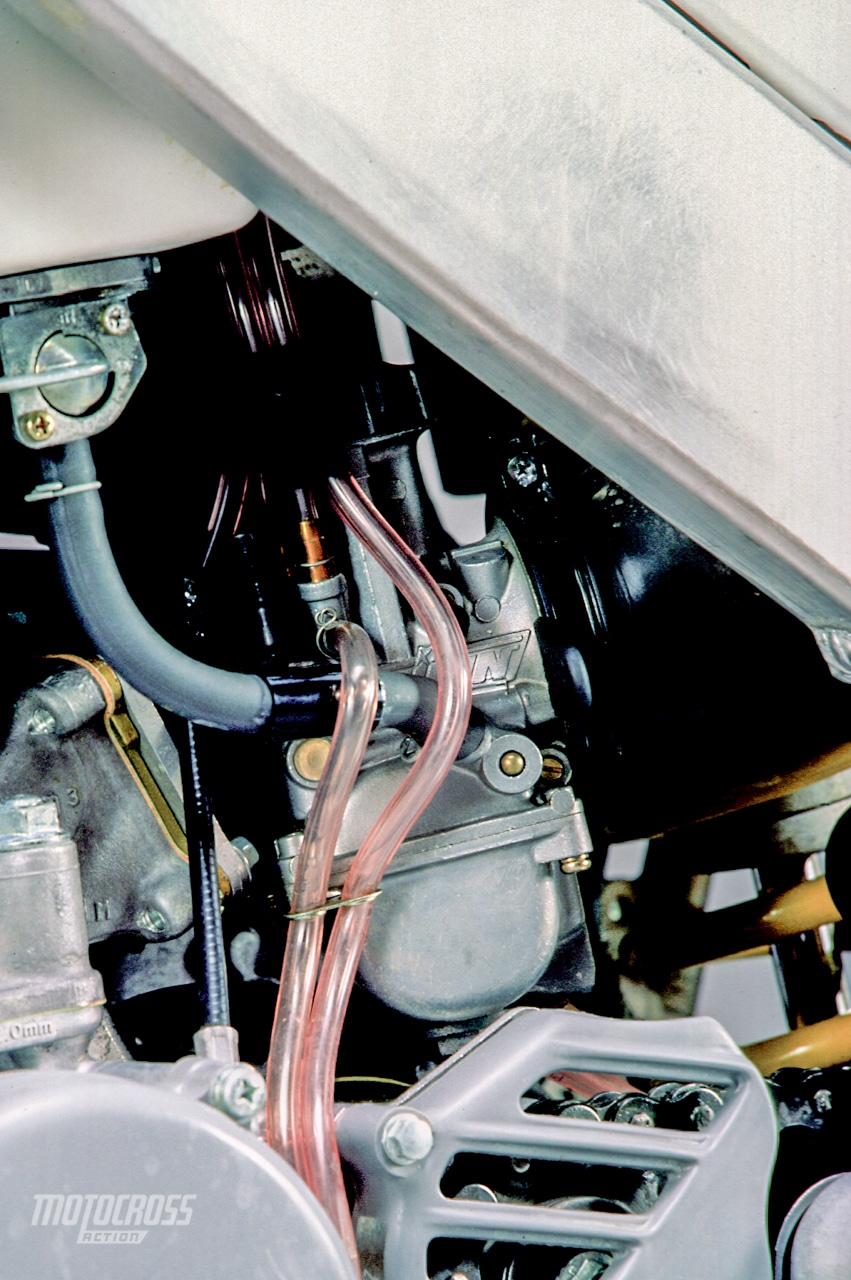
31. Trim the radiator shrouds where they rub against the frame.
32. Check the piston ring end gap when servicing the top end. The optimum measurement is .015 inches and a tight ring can be filed to the proper gap if necessary. Use a fine file to lightly chamfer the edge of a new piston skirt.
33. The power valve linkage is often misaligned when the cylinder is reinstalled. Visually check that the pin in the case lines up with the fork in the cylinder. The valve is under spring preload and it is often necessary to counter the tension to line the fork over the pin.
34. Frequently remove the right side power valve cover and check the condition of the valves and linkage. Rotate the valves by hand and feel to see if they are sticky. Although contact cleaner dispels oil residue, it cannot not remove built-up varnish.
35. Frequently check the reeds for cracks and chips. Most race teams use the stock petals, but they wear out quickly. If you are looking for more durability, Team FMF suggests running an aftermarket carbon replacement and Planet Honda says they’ve had success with Boyesen fiberglass replacements.
36. There is a nook up inside the front of the rear brake caliper hydraulics that likes to trap air. Unbolt the caliper and hold it upright in the air when bleeding the brakes. Pry the pads apart and remount the caliper. Bleed the front and rear brakes often if you are a crasher. (It’s possible for air to mix throughout the hydraulics as the bike cartwheels down the track.)
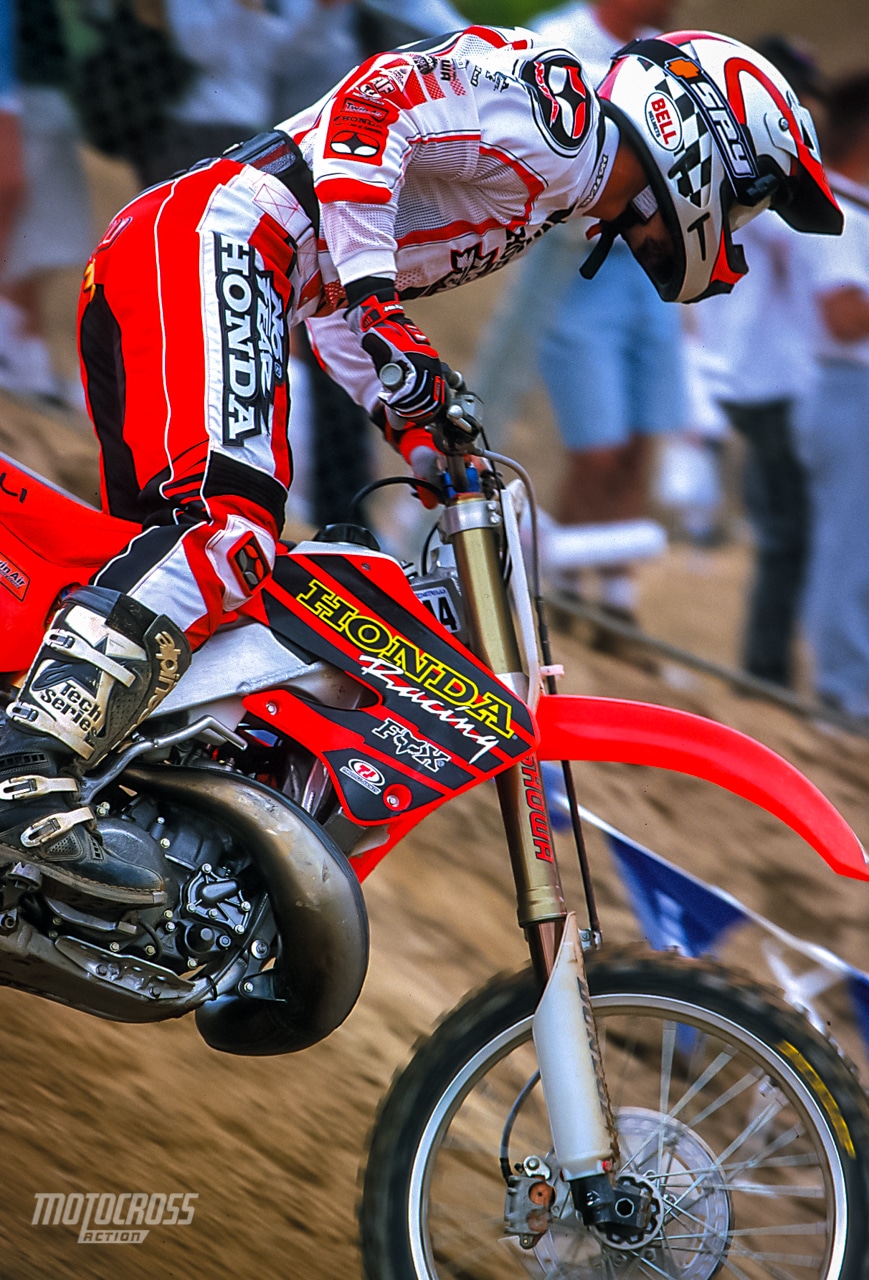 Sebastien Tortelli on a factory 1999 Honda CR250.
Sebastien Tortelli on a factory 1999 Honda CR250.
37. Planet Honda replaces the stock triple-clamp mounted front brake hose guide with a number plate-mounted guide from IMS. They claim much improved hose movement.
38. Honda’s aluminum clutch drive plates quickly contaminate the gearbox oil (requiring the oil to be changed after each ride). Honda recommends their own GN4 10/40 oil, but any quality 10/40 motor oil will do.
39. Team FMF says that the stock tire tubes are thin and should be switched out with regular Dunlop replacement tubes. The stock tubes don’t hold air very well, so check tire pressure before each ride.
40. Cut 20mm lengths of hi-temp hose with an ID that snuggly fits over the exhaust springs. Use contact cleaner to slip the hose on the spring. This cuts down on vibration. Loctite and keep an eye on the pipe bolts. Since this is a high-maintenance area, don’t use anything stronger than blue thread lock.
41. Run four exhaust spacers between the pipe and manifold (#18309-K23-600). The increased head pipe length makes delivery noticeably torquier off the bottom.
42. Change to a metal ACG cover (that’s is Honda tech speak for an aluminum ignition cover.) Although the metal cover seals better than the stock plastic unit, still take it off after each wash, spray the innards with WD40 and keep the cover off until the next ride.
43. If your track runs an Open class, RPM’s 285 kit gives a six horse boost throughout the range with much improved over rev. It runs $750.


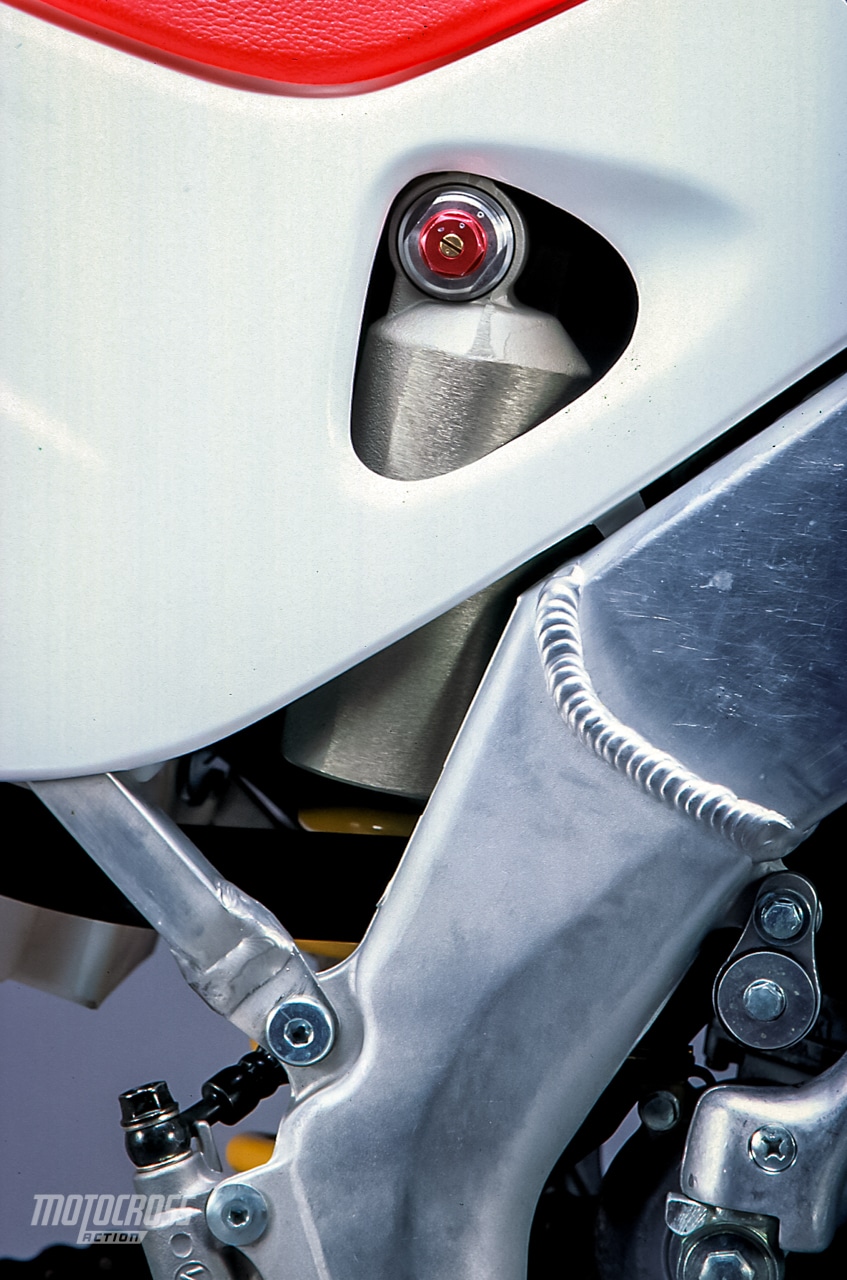
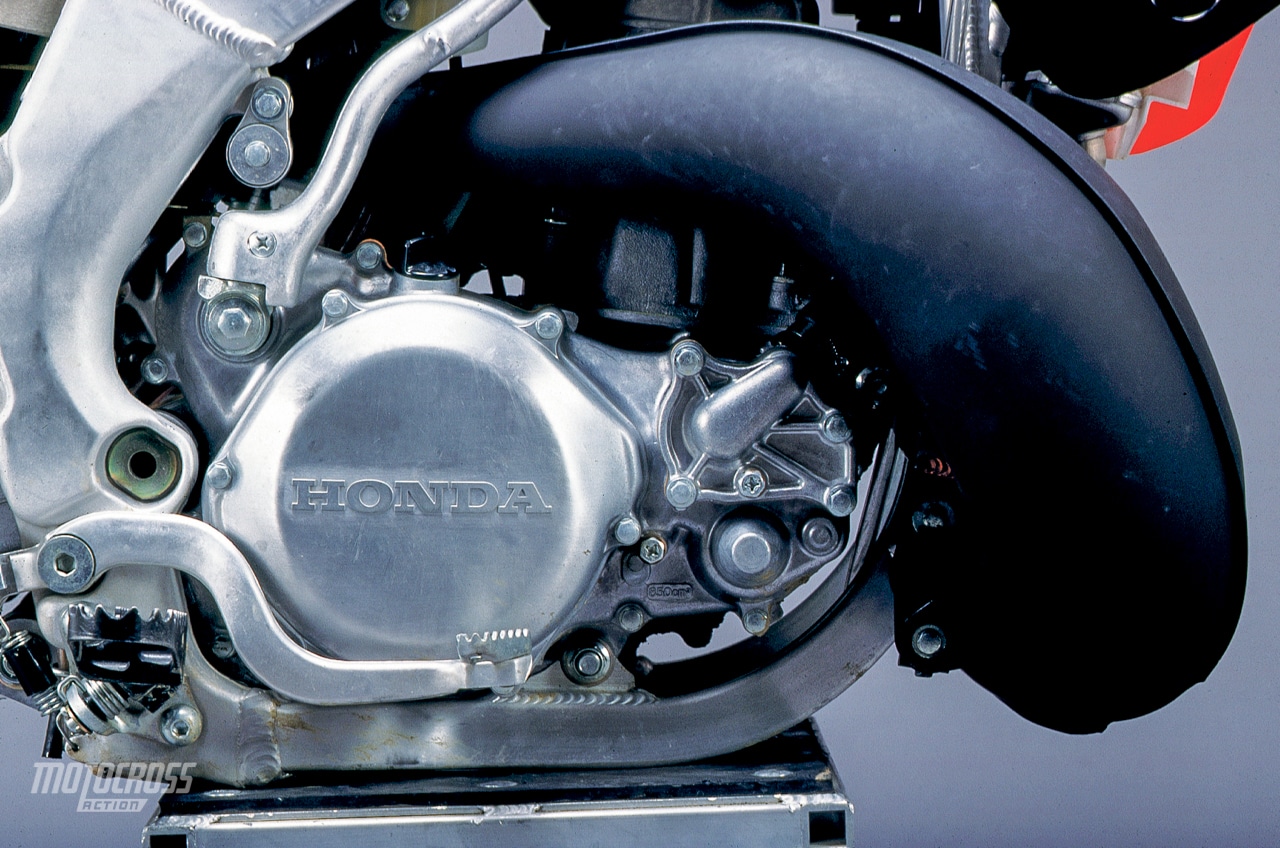




Comments are closed.